This was published 11 months ago
‘None of us had a choice in this’: How these man-made chemicals will affect us for generations
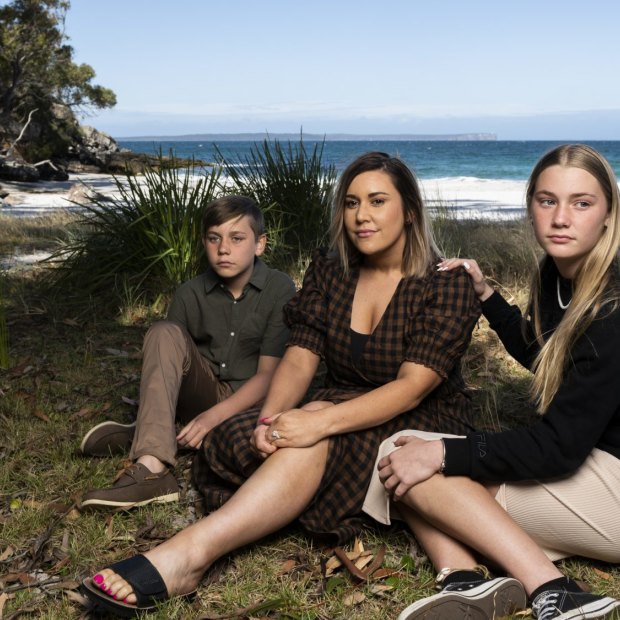
Wreck Bay resident Ashlee Williams-Barnes appears in a new documentary about forever chemicals. She was told to say her goodbyes to her children after being diagnosed with a late stage cervical cancer in 2015.Credit: Rhett Wyman
When the legal settlement from manufacturer 3M over water pollution by so-called “forever chemicals” hit the headlines last month, the payout figure of $US10.3 billion ($16 billion) might have made it seem like the issue had reached its reckoning point.
But the makers of a new documentary about the extent and impact of global contamination by toxic man-made chemicals describe the issue as a generational one. And so far, we may have only seen the tip of the legal liability iceberg.

3M Global Headquarters in Maplewood, Minnesota.Credit: Bloomberg
“We’ve only really just started to understand the sheer scope of this issue, how far this contamination has spread and the effects that it will have on us and on future generations,” director Katrina McGowan said.
“These chemicals pass from mother to child, they are persistent in the environment and will never break down, so the impacts will be felt for generations to come. It really is the tip of the iceberg. The science is still evolving, and we’re yet to really understand what that means for us.”
The obvious historical comparison is the legal tidal wave that began sweeping over Big Tobacco two decades ago, but, even on those terms, US environmental lawyer Robert Bilott said, the issue of man-made chemical contamination is potentially far greater.
“With tobacco, except for secondhand smoke and other issues, most people at least understood they were picking up a cigarette,” Bilott said. “With [forever chemicals] none of us had a choice in this. None of us knew we were being exposed.”
Revealed: How to Poison a Planet explores that exposure, and the extent to which the use of PFAS – or Per- and Polyfluorinated Substances – in products that resist heat, oil, stains, grease and water, have contaminated global water and ecosystems, and even our own bodies.
Those substances are found in everything from nonstick cookware and stain-resistant fabrics and carpets, to water-repellent clothing, grease-, water- and oil- resistant products and some firefighting foams. They are in school uniforms. They can be found in adhesives, and even in food packaging.
What is acutely frightening about PFAS is that, unlike naturally occurring toxic nasties such as lead and arsenic, they are wholly man-made. “We’re talking about a family of completely man-made chemicals that didn’t exist on the planet prior to the 1940s,” Bilott said.
“Not only had they been used in a massive array of products, they’ve got an incredibly disturbing signature of being toxic, persistent, and bioaccumulative. And some of them have now been shown to be carcinogenic as well.”
Worse, Bilott said, they travel with ease. “They move through the air, through the water, through the groundwater, through living things, [and] now, we are dealing with chemicals that are literally contaminating the entire planet.
“They’re falling in the rain on the mountains of Tibet, they’re being found in the blood of polar bears, they’re being found in the blood of almost every person on the planet,” he said. “[It is a] truly unprecedented scope and scale of environmental contamination I don’t think we’ve seen before.”
Revealed: How to Poison a Planet is the end of a long investigative journey which begins in Parkersburg, West Virginia, in 1999, travels to Australia via Wreck Bay, an Aboriginal community in the Jervis Bay Territory, and ends in South Carolina in the United States, where 3M finally agreed to pay the $10.3 billion settlement against claims it polluted thousands of water supplies across the country. It brings together a complex cast of personalities.
They include Walkley Award-winning Sydney Morning Herald journalist Carrie Fellner, who spent almost a decade reporting on the issue from an Australian perspective, Hollywood actor Mark Ruffalo, who played Bilott in the 1999 film Dark Waters, Bilott himself and documentary producers McGowan, Janine Hosking and Mat Cornwell, and US lawyers Ned McWilliams, Gary Douglas and Rebecca Newman.
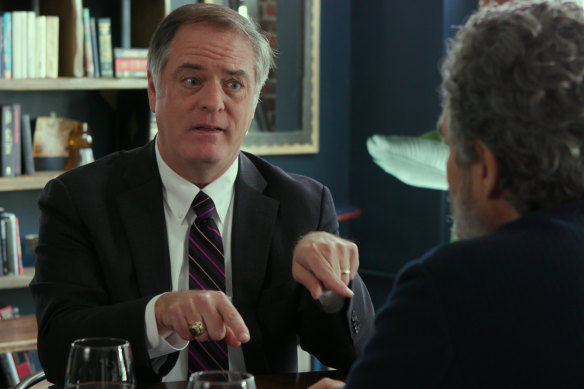
Lawyer Robert Bilott took on a case against chemical contamination that shone the light on forever chemicals.
But to understand the origin of the story, we have to go back to 1999, when Bilott took on the case of Parkersburg farmer Wilbur Tennant, whose livestock were dying. Tennant suspected the neighbouring property, a chemical plant owned by DuPont, was leaching contaminated water through a discharge pipe.
Tennant and DuPont, which was using PFAS to manufacture Teflon, came to an undisclosed settlement in 2001 but, since then, more than 15,000 claims have been filed in the US against DuPont, two of its related companies Chemours and Corteva, and 3M, the major manufacturers of PFAS.
So, how come so few people seem to know about the story? The problem, Bilott said, is that the chemical villains of the piece have only been known as “PFAS” for the past few years. Initially, they were referred to as C8, a name taken from C8HF15O2, the formula for perfluorooctanoic acid.
Then, for a time, they were known as PFCs, or perfluorocarbons, referring to the chemical group used to make fluoropolymer coatings. Even PFAS, the term we now use, is not exactly catchy.
Their plain English name “forever chemicals” was coined because they don’t break down and can persist in water and soil indefinitely. “These are chemicals that have incredibly long, complicated names that do not roll off the tongue,” Bilott said. “It’s not like lead, arsenic, cyanide, things that people immediately understand [to be] a nasty chemical.
“This is stuff you can’t see, you can’t taste, you can’t smell, you can’t even pronounce it,” he said. “And it’s referred to 15 different ways. So that was certainly part of what has contributed to this story taking so long to actually come out and resonate with the public.”
The story landed on Hollywood’s doorstep in 2016 when Mario Correa and Matthew Michael Carnahan wrote a script titled Dry Run, based on a New York Times Magazine article about Bilott, “The Lawyer Who Became DuPont’s Worst Nightmare”.
In Los Angeles, Ruffalo saw the story and contacted Bilott, asking how it was possible that, in 2016, a modern industrialised country like the US could be grappling with these kinds of contaminations. “[He asked me,] ‘How has this been going on this long? And why are we not talking about this?’ ” Bilott said.
By the time principal photography began in January 2018, the film – a dramatisation of Bilott’s 1998 case against DuPont – was titled Dark Waters and Ruffalo was playing him. Despite its modest success – just $US23.1 million at the box office, and ignored by both the Oscars and the Golden Globes – the film was critical in bringing the story into the national spotlight, Bilott said.
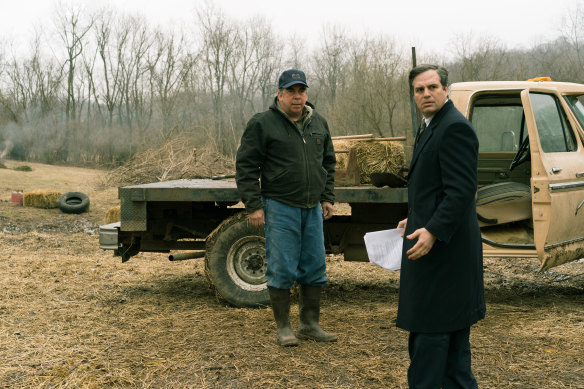
Bill Camp (left) as farmer Wilbur Tennant and Mark Ruffalo as Robert Bilott in Dark Waters.Credit: Netflix
“We are seeing things happen in the United States that I never thought I’d see in my lifetime,” says Bilott. “The movie was critical because it was able to take a very complicated story and present it to the public in a way that they were able to understand.”
Less than a week ago in the US, the Environmental Protection Agency designated two key PFAS chemicals – perfluorooctanoic acid (PFOA) and perfluorooctanesulfonic acid (PFOS) – as hazardous substances, tightening rules around transparency and accountability in relation to their use. “These are huge developments,” Bilott said.
And for Ruffalo, it became more than an acting gig. The 56-year-old actor co-produced Dark Waters, campaigned against the use of forever chemicals and testified before a House Oversight Committee meeting in Washington, DC, tasked with dealing with chemicals that were leaching into the US water supply.
PFAS manufacturers such as 3M and DuPont “made billions upon billions of dollars producing chemicals they knew were building up in our blood, and they knew they were toxic but failed to tell anyone,” Ruffalo told the committee in 2019. “In America, it falls to us, the ordinary people, to prove that these chemicals are toxic before the chemical is regulated by our government. That is simply backwards.”
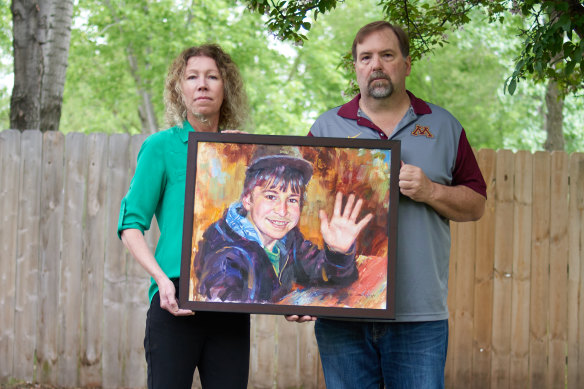
Minnesota parents Melissa and Jim Crowley hold a portrait of their son Alex Crowley, who attended a school close to a 3M facility and died of brain cancer.Credit: David Bowman
In Australia, meanwhile, Fellner had worked on several investigations into PFAS-related contaminations, one in Williamtown, NSW, connected to firefighting foam use on the RAAF base, and another, which took her to the US, connected to a cluster of cancer cases among the students of Tartan High School, next to 3M’s headquarters. In 2004, forever chemicals were detected in the local public water supply.
McGowan, Hosking and Cornwell, also on the PFAS trail, were interested in her work, and it was McGowan’s suggestion that Fellner investigate the Wreck Bay case. “It became obvious that it was something we could do together because she’d done such a great job on her investigation,” McGowan said.
The pair then spent two years working together. Fellner produced a series of articles for the Herald, “Paradise Poisoned”, about the impact PFAS had on Wreck Bay.
The Herald investigation, which won the team a Walkley Award and a Kennedy Award, revealed devastating sickness and death in Wreck Bay, and contamination of its water supply, food supply and sacred sites. The village is situated adjacent to a Department of Defence base that used toxic firefighting foam for decades.
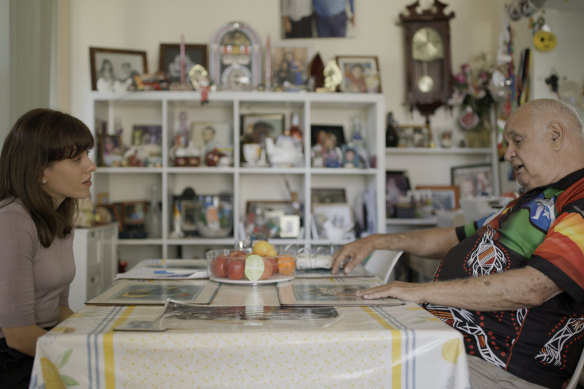
Carrie Fellner talking to Uncle Jack Hampton from Wreck Bay, who has lost many friends to heart attacks or cancer.Credit: Stan
At the heart of Revealed is a trove of 3M documents uncovered during discovery for the multibillion-dollar lawsuit the company recently settled.
“While I was researching in 2022 I stumbled upon a motion from a US court case trying to compel 3M to hand over the records of its former chairman,” Fellner said. “I was stunned to realise this mammoth case over forever chemicals had basically gone unreported by the world’s media.
“Katrina then dedicated the next year to forging a relationship with the US legal team pursuing the case against 3M. Her efforts were able to secure the documentary team extraordinary behind-the-scenes access to the case.
“After the case settled, the lawyers agreed to share a cache of explosive 3M documents and deposition videos with us. This gave the Herald a world-exclusive article and Katrina did an incredible job bringing the documents to life on the screen.
”By working together, we had the privilege of being the first to tell the full story behind one of the biggest environmental lawsuits in American history.”
The Australian team spoke to key US lawyers: McWilliams, Douglas, Newman and Bilott. Bilott’s relationship with Ruffalo brought the actor on board. Stan, Screen Australia, the Shark Island Foundation and Screen NSW funded the documentary.

Lawyer Gary Douglas was part of the team that pursued 3M over the contamination of US water supplies.
Fellner’s work was already on Bilott’s radar because headlines about class action litigation in connection with toxic firefighting foam and the Australian government’s denials had caught his eye.
“[The government] were apparently not seeing the science that was here in the United States showing these pretty well-documented links between exposure to PFOA, for example, and pretty serious diseases, including cancer,” he said.
Taking the story to the global stage was critical, Bilott added. “For me, one of the things that’s really troubling to see is the same chemicals being found in water all over the world, yet, when they pop up, it’s as if this is something new,” he said.
“We’ve got decades of science and decades of information that is available. Communities don’t have to repeat what happened in West Virginia. We can build off what we know here and move forward. This is not just a West Virginia story. It’s not just a United States story. This is a global story.”
The 58-year-old New York-born lawyer has high praise for the investment in journalism made by entities such as The Sydney Morning Herald, which has supported Fellner’s work and The New York Times and the Fund for Investigative Journalism, which backed the work of writers such as Nathaniel Rich and Mariah Blake, whose work contributed to Dark Waters.
“The power of investigative journalism is massive, and we need to be supporting this kind of journalism,” Bilott said. “Take the PFAS story, some of the first [instances of] getting this story out were through newspapers that were able to fund long, complicated stories. This kind of investigative reporting is what makes the difference.”
But standing as a sometimes solitary voice in the media is a challenge in itself. Few mainstream media outlets are willing to cover the story in as much depth as the handful of outlets globally that have invested in substantial journalism on the topic.
“Oftentimes in the media you get sort of a pack mentality but, with PFAS, there hasn’t been a lot of broad interest in the media for a lot of this journey, so that leads you to sometimes feeling a little bit exposed, but also that makes it a good story, too,” Fellner said.
There is a David-and-Goliath-like aspect of the battle between small communities and gigantic corporations, or governments, but Fellner said that aspect had never daunted her.
“It adds another layer of scrutiny to your work when you are taking on powerful players like that, knowing that you have to cross every t and dot every i,” she said.
The story is now generational, Fellner said, certainly in the sense that it would most likely take decades before anything resembling a final legal outcome was reached.
The landmark water supply settlement in the US does not relate to any personal injury claims that might form the basis of future litigation, such as the battery of lawsuits that came for the tobacco industry. (The Tobacco Master Settlement Agreement payout, agreed to in 1998, was a minimum of $US206 billion over the first 25 years of the agreement.)
“I would love to say it’s nearly over because I’ve been doing it for about nine years, but we haven’t even seen in Australia any legal action over health effects; so far, it’s all been for property devaluation,” Fellner said. In the US, she added, “They have armies of people waiting on the sidelines to sue over health effects.”
And while the legal battles over tobacco and forever chemicals are superficially similar, Bilott agrees, the latter casts a substantially wider net.
And the past 2½ decades are probably just the first steps in a much longer journey.
“We’ve all been unwittingly contaminated with this stuff,” Bilott said. “It’s not just our drinking water. It’s in our soil, it’s in our properties, it’s in us. So the impacts are bigger. It’s not just personal impacts, it’s environmental impacts, it’s societal impacts. It’s massive in scope.”
Revealed: How to Poison a Planet will stream on Stan from April 28.
Start the day with a summary of the day’s most important and interesting stories, analysis and insights. Sign up for our Morning Edition newsletter.